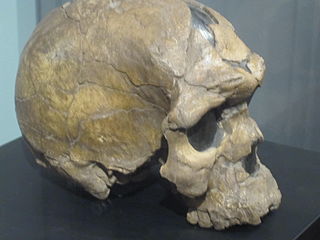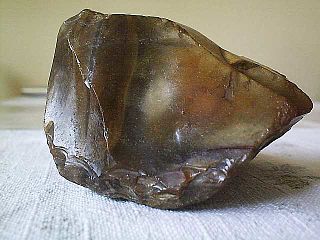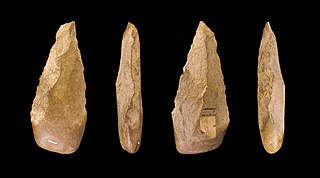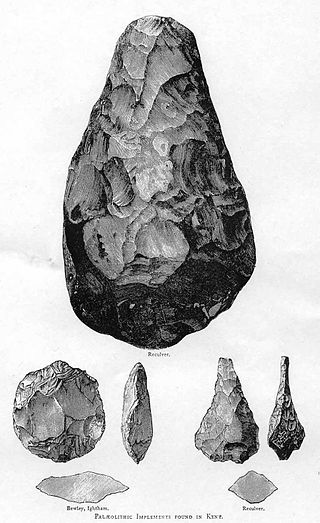
The Stone Age was a broad prehistoric period during which stone was widely used to make stone tools with an edge, a point, or a percussion surface. The period lasted for roughly 3.4 million years and ended between 4,000 BC and 2,000 BC, with the advent of metalworking. Though some simple metalworking of malleable metals, particularly the use of gold and copper for purposes of ornamentation, was known in the Stone Age, it is the melting and smelting of copper that marks the end of the Stone Age. In Western Asia, this occurred by about 3,000 BC, when bronze became widespread. The term Bronze Age is used to describe the period that followed the Stone Age, as well as to describe cultures that had developed techniques and technologies for working copper alloys into tools, supplanting stone in many uses.
A stone tool is, in the most general sense, any tool made either partially or entirely out of stone. Although stone tool-dependent societies and cultures still exist today, most stone tools are associated with prehistoric cultures that have become extinct. Archaeologists often study such prehistoric societies, and refer to the study of stone tools as lithic analysis. Ethnoarchaeology has been a valuable research field in order to further the understanding and cultural implications of stone tool use and manufacture.

The Olduvai Gorge or Oldupai Gorge in Tanzania is one of the most important paleoanthropological localities in the world; the many sites exposed by the gorge have proven invaluable in furthering understanding of early human evolution. A steep-sided ravine in the Great Rift Valley that stretches across East Africa, it is about 48 km long, and is located in the eastern Serengeti Plains within the Ngorongoro Conservation Area in the Olbalbal ward located in Ngorongoro District of Arusha Region, about 45 kilometres from Laetoli, another important archaeological locality of early human occupation. The British/Kenyan paleoanthropologist-archeologist team of Mary and Louis Leakey established excavation and research programs at Olduvai Gorge that achieved great advances in human knowledge and are world-renowned. The site is registered as one of the National Historic Sites of Tanzania.

A hand axe is a prehistoric stone tool with two faces that is the longest-used tool in human history. It is made from stone, usually flint or chert that has been "reduced" and shaped from a larger piece by knapping, or hitting against another stone. They are characteristic of the lower Acheulean and middle Palaeolithic (Mousterian) periods, roughly 1.6 million years ago to about 100,000 years ago, and used by Homo erectus and other early humans, but rarely by Homo sapiens.

Acheulean, from the French acheuléen after the type site of Saint-Acheul, is an archaeological industry of stone tool manufacture characterized by the distinctive oval and pear-shaped "hand axes" associated with Homo erectus and derived species such as Homo heidelbergensis.

The Oldowan was a widespread stone tool archaeological industry (style) in prehistory. These early tools were simple, usually made with one or a few flakes chipped off with another stone. Oldowan tools were used during the Lower Paleolithic period, 2.9 million years ago up until at least 1.7 million years ago (Ma), by ancient Hominins across much of Africa. This technological industry was followed by the more sophisticated Acheulean industry.

Herto Man refers to human remains discovered in 1997 from the Upper Herto member of the Bouri Formation in the Afar Triangle, Ethiopia. The remains have been dated as between 154,000 and 160,000 years old. The discovery of Herto Man was especially significant at the time, falling within a long gap in the fossil record between 300 and 100 thousand years ago and representing the oldest dated H. sapiens remains then described.

The Kalambo Falls on the Kalambo River is a 235-metre (772 ft) single-drop waterfall on the border of Zambia and Rukwa Region, Tanzania at the southeast end of Lake Tanganyika. The falls are some of the tallest uninterrupted falls in Africa. Downstream of the falls is the Kalambo Gorge, which has a width of about 1 km and a depth of up to 300 m, running for about 5 km before opening out into the Lake Tanganyika rift valley. The Kalambo waterfall is the tallest waterfall in both Tanzania and Zambia. The expedition which mapped the falls and the area around it was in 1928 and led by Enid Gordon-Gallien. Initially it was assumed that the height of falls exceeded 300 m, but measurements in the 1920s gave a more modest result, above 200 m. Later measurements, in 1956, gave a result of 221 m. After this several more measurements have been made, each with slightly different results. The width of the falls is 3.6–18 m.

The Clactonian is the name given by archaeologists to an industry of European flint tool manufacture that dates to the early part of the interglacial period known as the Hoxnian, the Mindel-Riss or the Holstein stages. Clactonian tools were made by Homo heidelbergensis.

The Lower Paleolithic is the earliest subdivision of the Paleolithic or Old Stone Age. It spans the time from around 3.3 million years ago when the first evidence for stone tool production and use by hominins appears in the current archaeological record, until around 300,000 years ago, spanning the Oldowan and Acheulean lithics industries.

In archaeology, a cleaver is a type of biface stone tool of the Lower Palaeolithic.
The Soanian culture is a prehistoric technological culture from the Siwalik Hills in the Indian subcontinent. It is named after the Soan Valley in Pakistan. Soanian sites are found along the Siwalik region in present-day India, Nepal and Pakistan. The Soanian culture has been approximated to have taken place during the Middle Pleistocene period or the mid-Holocene epoch (Northgrippian). Debates still goes on today regarding the exact period occupied by the culture due to artefacts often being found in non-datable surface context. This culture was first discovered and named by the anthropology and archaeology team led by Helmut De Terra and Thomas Thomson Paterson. Soanian artifacts were manufactured on quartzite pebbles, cobbles, and occasionally on boulders, all derived from various fluvial sources on the Siwalik landscape. Soanian assemblages generally comprise varieties of choppers, discoids, scrapers, cores, and numerous flake type tools, all occurring in varying typo-technological frequencies at different sites.

The Bouri Formation is a sequence of sedimentary deposits that is the source of australopithecine and Homo fossils, artifacts, and bones of large mammals with cut marks from butchery with tools by early hominins. It is located in the Middle Awash Valley, in Ethiopia, East Africa, and is a part of the Afar Depression that has provided rich human fossil sites such as Gona and Hadar.
Kartan industry is the archaeological production, probably more than 10,000 years ago, of a large quantity of exceptionally large stone tools that were found on Karta, known since 1802 as Kangaroo Island, South Australia.

The following outline is provided as an overview of and topical guide to prehistoric technology.
Kariandusi prehistoric site is an archaeological site in Kenya. Located on the southeastern edge of the Great Rift Valley and on Lake Elmenteita, Kariandusi is an African Early Stone Age site dating to approximately 1 million years ago.

Nicholas Patrick Toth is an American archaeologist and paleoanthropologist. He is a Professor in the Cognitive Science Program at Indiana University and is a founder and co-director of the Stone Age Institute. Toth's archaeological and experimental research has focused on the stone tool technology of Early Stone Age hominins who produced Oldowan and Acheulean artifacts which have been discovered across Africa, Asia, the Middle East, and Europe. He is best known for his experimental work, with Kathy Schick, including their work with the bonobo Kanzi who they taught to make and use simple stone tools similar to those made by our Early Stone Age ancestors.
Gona is a paleoanthropological research area in Ethiopia's Afar Region. Gona is primarily known for its archaeological sites and discoveries of hominin fossils from the Late Miocene, Early Pliocene and Early Pleistocene. Fossils of Ardipithecus and Homo erectus were discovered there. Two of the most significant finds are an Ardipithecus ramidus postcranial skeleton and an essentially complete Homo erectus pelvis. Historically, Gona had the oldest documented Oldowan artifact assemblages. Archaeologists have since found older examples of the Oldowan at other sites. Still, Gona's Oldowan assemblages have been essential to the archaeological understanding of the Oldowan. Gona's Acheulean archaeological sites have helped us understand the beginnings of the Acheulean Industry.

Chesowanja is a Kenian archaeological site located in the north of the Kenya Rift Valley, east of Lake Baringo. The Chesowanja sites consist of quaternary sediments. The sites are home to various discoveries like fossils, evidence of human activity over a period of 2 million years and the remains of Australopithecus. Also, artefacts belonging to Oldowan technology, Acheulean tradition and later stone industries have been found.















